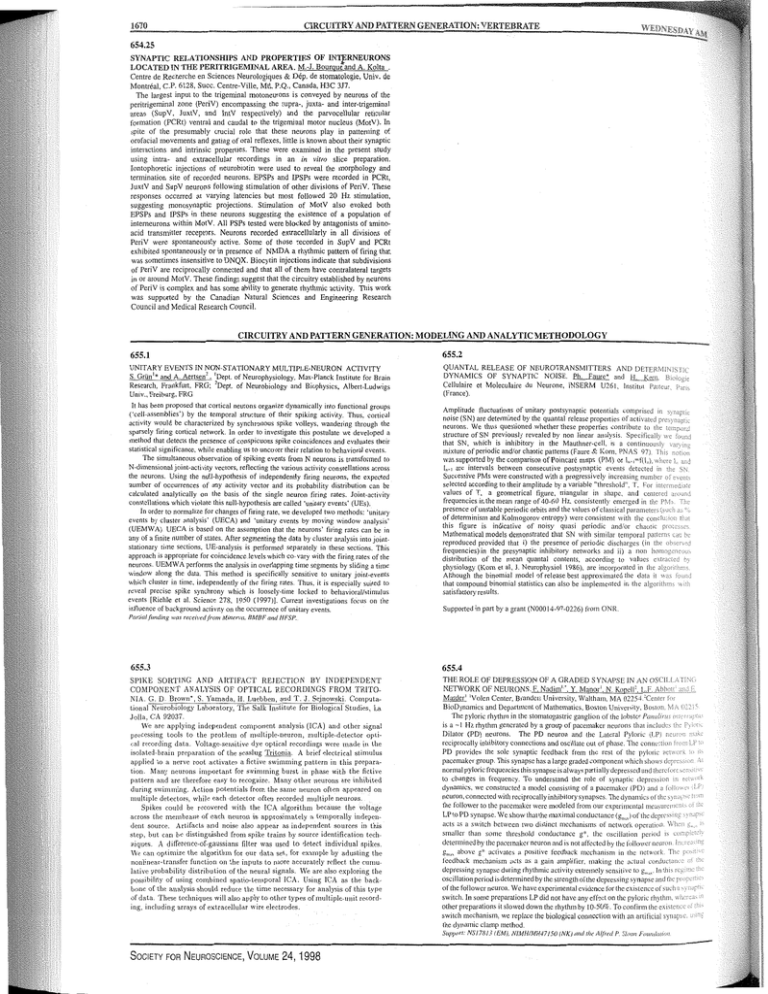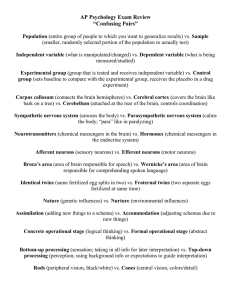Document 10493887
advertisement

RELATlONSHIPS AND PROPERTIES OF INTERNEURONS
IN THE PEMTRIGEMINAL AREA. M:J. Bour~uekandA. Kolta .
cherche en Sciences Neurologiques & DCp. de stomatologie, Univ. de
The largest input to the trigeminal motoneurons is conveyed by neurons of the
peritrigeminal zone (PeriV) encompassing the supra-, juxta- and inter-trigeminal
areas (Sup\', JuxtV, and IntV respectively) and the parvocellular reticular
formation (PCRt) ventral and caudal to the trigeminal motor nucleus (MotV). In
spite of the presumably crucial role that these neurons play in patterning of
oroiac~almovements and gating of oral reflexes, little is known about their synaptic
interactions and intrinsic properties. These were examined in the present study
using intra- and extracellular recordings in an in viwo slice preparation.
Iontophoretic injections of neurobiotin were used to reveal the morphology and
termination site of recorded neurons. EPSPs and IPSPs were recorded in PCRt,
IuxtV and SupV neurons following stimulation of other divisions of PeriV. These
responses occurred at varying latencies but most followed 20 Hz stimulation,
suggesting monosynaptic projections. Stimulation of MotV also evoked both
EPSPs and IPSPs in these neurons suggesting the existence of a populatton of
interneurons within MotV. All PSPs tested were blocked by antagonists of aminoacid transmitter receptors. Neurons recorded extracellularly in all divisions of
PeriV were spontaneously active. Some of those recorded in SupV and PCRt
exhibited spontaneously or in presence of NMI)A a rhythmic pattern of firing that
was sometimes insensitive to DNQX. Biocytin injections indicate that subdivisions
of PeriV are reciprocally connected and that all of them have contralateral targets
in or around MotV. These findings suggest that the circuitry established by neurons
of PeriV is complex and has some ability to generate rhythmic activity. This work
was supported by the Canadian Natural Sciences and Engineering Research
Council and Medical Research Council.
655.1
UNITAPY EVENTS IN NON-STATIONARY MULTIPLE-NEURON ACTIVITY
S Grun * and A. Aertsen2 . 'Dept. of Neurophysiology. Max-Planck Instttute for Braln
Research, Frankfurt, FRG; 'Dept, of Neurobiology and Biophysics. Albert-Ludwigs
Un~v.,Freiburg, FRG
It has been proposed that cortical neurons organtze dynvmtcally tnto functronal groups
('cell-assemblies') by the temporal structure of their sp~kingactivity. Thus, cortical
acttvity would be characterized by synchronous sp~kevolleys, wandering through the
sparsely firing corttcal network. Ie order to investigate this postulate we dweloped a
method that detects tlte presence of conspicuous spike coincidences and evaluates thew
stat~sticalstgnificatice, wh~leenabling us to uncover their relation to behavioral events.
The sin~ultaneousobservation of spiking events from N neurons is transformed to
N-dimens~onaljoint-activ~tyvectors, reflecting the various activ~tyconstellations across
the neurons. Ustng the null-hypothes~sof mdependently firtng neurons, the expected
number of occurrences of any activity vector and ~ t sprobab~lity d~strtbutto~l
can be
calculated analytically on the basis of the single neuron firmg rates. Joint-acttvity
consrcllations which violate this null-hypothesis are called 'un~taryevents' (UEs).
In order to normalize for changes of firing rate, we developed two methods: 'unitary
events by cluster analysis' (UECA) and 'unitary events by moving wndow analys~s'
(UEMWA). UECA IS based on the assumption that the neurons' firing rates can be 1s
any of a finite number of states. After segmenting the data by cluster analysis tnto~omtstatlonary time sections, UE-analysis is performed separately In these sections. This
approach is appropriate for coinc~dencelevels which co-vary with the firing rates of the
neurons. UEMWA performs the analysis In overlapptng time segments by sliding a time
window along the data. This metliod is specifically sens~tiveto unltary joint-events
which cluster in time. independently of the firing rates Thus, i t is especially suited to
reveal precise spike synchrony which is loosely-t~melocked to beiiavtorallsti~llulus
events [Riehle et al. Science 275, 1950 (1997)J. Current investtgations focus on the
mtluence of background actlvlty on the occurrence of unltary events.
QUANTAL RELEASE OF NEUROTRANSMITTERS AND D t l t : R M i * \ ; ~ : ~
:3,,.:,.!,DYNAMICS OF SYNAPTIC NOISE. Ph. Faure* and
Cellulaire et Moleculaire du Neorone, INSERM U261, lristitut i'd,ic,:
,au .
(France).
u,
Anlplitude fluctuations of unitary postsynaptic poteot~als
noise (SN) are detennined by the quantal release propectm
neurons. We thus questioned whether these properties con
structure of SN previously revealed by noti linear analysis S
that SN, which is inhibitory in tlie Mauthner-cell, IS ,
tntxture of per~odicandlor chaotic patterns (Faure & ICorti. I
was supponed by the comparison of Po~ncaremaps (PM) o
I,+, are intervals between consecutive postsynaptic events
Successive PMs were constructed with a progressively increos ,
selected according to their amplitude by a variable "threshold", '1.
\%dues of T, a geometrical figure, trtangular iti sl~ape. and c
frequencies in the tnean range of40-60 Hz, cotisistcntly enierged I
presence ofunstable periodic orbttc and the values ofclass~calp a .
of determinism and Kolmogorov entropy) were consistent \vitli ti
this figure is indicative of tiotsy quasi periodic andior
Mathematical models demonstrated that SN with simrlar tempo
reproduced provided that i) the presence or periodlc dmtiaigc
n'equencies)in the presyoaptic inhibitory tietworhs and ii) a tioii
distribution of tlie tnean quantal contents, according to value
phys~olosy(Kom et a!, 3 . Newophysiol 1986). are incorporated
Although the binonilal ttlodcl of release best approunnated t11c
that compound binom~alstatistics can also be implenlenred in tit
satisfactoryresults.
Suppotted in pan by a grant (N000l4-97-0226) from ONR
Prtnial herd8iirzg was recen~edfioirtMmcnv~,
BMDFntrdHFSP
655.4
SPIKE SORTING AND ARTIFt\CT REJECTION BY INDEPENDENT
COhIPONENT ANAISSIS O F OPTICAL RCCORD1NC;S FROM TRITONIA. G . D. B r o w n , S. Yamada, 11. Loebben, and T . J . Se,jnowski. Cornpotational Ncurobiology Laboratory, The Salk Lnstitirte for Btologtcal Storiies, La
J d a , CA 92037.
Wc are applying independent component analysis (ICA) and other sigtlal
processing tools to the problem of mulliple-neuron, multiple-detect,or optical recording data. Voltage-sensitive dye optical recordings were made in the
A brief electrical stinlulus
~solated-brainpreparation of the seaslog
upplied to a nerve root activates u fictive swimming patiwn ill this preparat ~ o n .Many neurons important for srrsimlning burst in phasc with the fictive
pattern and are titerefore easy lo recognize. Many other neuroris arc t n h i b ~ t d
during srviminitlg. Actton potentials from the same ueuron oken appeared on
multiple detectors, while each detector oftcn recorded multiplr neurons.
Spikes coiild be recovered wit11 the ICt\ algorittt~i~
because tile voltage
across the membrane of each neuron is approximatcly a temporally irtdepwdent source. Artifacls and noise also appear as independent sources in this
slcp, but can be distiiigoishcd from spike trains 1)y source identificat,ion trcllt~lques. ,\ dtiference-of-gaitssians filter was usrd lo detect individual spikes.
\Irc can optimize the algorithm for our data set, for example by adusting lltc
noniinrar-transfcr function on the inputs l o more accurately rrflect t,he culouiative probability distribution of the neural signals. We arc also exploring the
possibiltty of wing cotnhincd spatio-temporal ICA. Ustng ICA as the backbone of thc analysis should reducr the time necessary for atralysts of this type
of data These tecltniqurs will also apply to other types of toultiple-unit reeordin$, including arrays of extracellular wire electrodes.
m.
THE ROLE O F DkPRESSION O t A GRADkD SYN/\PSt IN A N O X i i i








